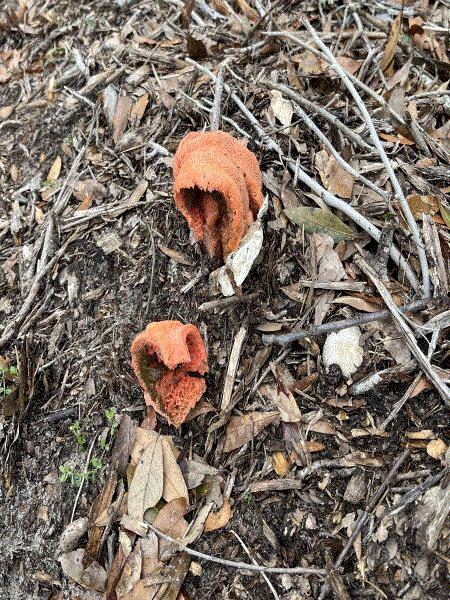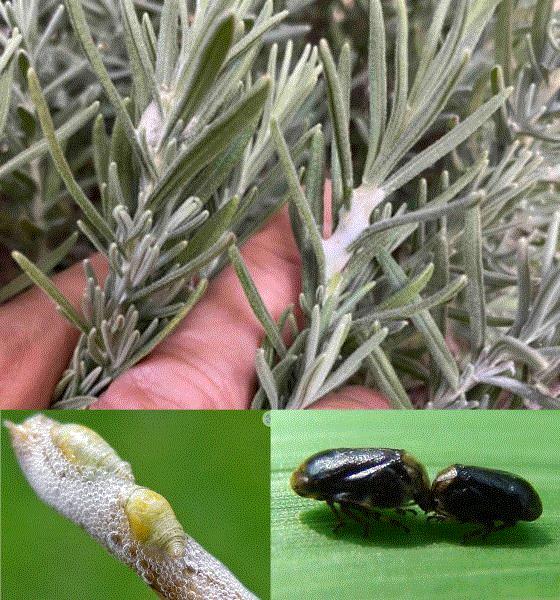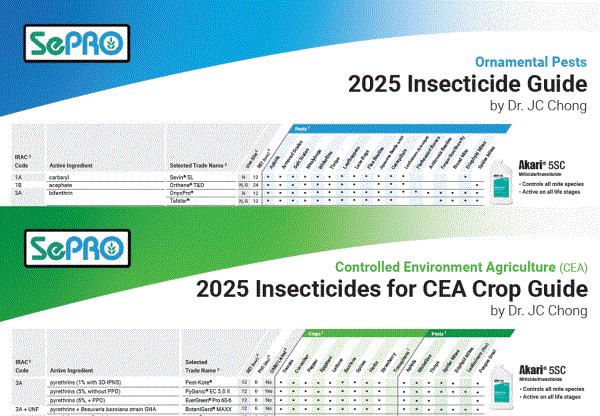What the ... ?
The heavy rains in the past week provided some relief from wildfire smoke and an extremely heavy pollen load. Even though precipitation in the month of March in Back Swamp, South Carolina, is still in deficit, I welcomed any amount of rain we got.
With returning rainfall and warming temperatures, I’m starting to see some signs of spring popping out of the ground. Rather, I could smell one of these creatures before I saw it. It smelled like something had died in the woods or some dog having gas problems. I looked at my wife’s dog (who was walking with me at the time), stared into her sheepish, innocent brown eyes, and concluded that the poor dog probably was not responsible for the olfactory offense.

What in the world was I smelling? Two orange piles of twisted mush were all that I saw when I finally located the source of the reeking stench.
This week’s mystery is an easy one. Other than the smell, it isn’t really a pest of anything.
A Pest JC Has Never Heard Of
Dan Gilrein of Cornell Extension educated me, via his most recent e-Gro Alert, on a new pest I’d never heard of before. Ever heard of the sunflower spittlebug? No? Well, that makes me feel better. I recommend going HERE and reading up on this new pest.
The sunflower spittlebug, Clastoptera xanthocephala, isn’t a new invasive species from somewhere in Asia or Europe. It’s likely a native species that has been known in the United States since 1900. They could be found widely in the southern states, although I’ve never seen or, rather, I’ve never paid any attention to them before. It appears that this spittlebug species has finally made their way to Long Island, New York, where Dan works. The first detection of this species in the region was in 2022 on chrysanthemums. Dan had found them infesting lavenders and goldenrods. They also feed, to a lesser extent, on mugworts and sunflowers.

Spittle on lavenders (top), nymphs in a spittle (bottom, left), and a pair of mating sunflower spittlebug adults (bottom, right). (Photo credit: Lavender by Dan Gilrein, Cornell Extension; nymphs by John R. Maxwell, bugguide.net; adults by Matt Edmonds, bugguide.net.)
Nymphs of the sunflower spittlebug produce frothy masses on the stems. You can find a light green to yellow nymph after you clear a spittle away. The adults are 1/8 in. long and range in color from dark tan to shiny black.
Dan suggests that a jet of water is sufficient to clean up the spittle on cutflowers. Many insecticides may work well, but none really is registered to control this species in New York State. (In New York, a pest species must be specifically mentioned on the label for a pesticide to be used to control that pest legally.) For folks outside of New York, I recommend insecticides that are registered for controlling leafhoppers, planthoppers or froghoppers, which I expect to work well against spittlebugs.

New Insecticide Posters
I want to do a little shameless self-promotion because I really want y’all to have a couple of resources I’ve just updated or developed.
In 2022, I developed a poster that listed most insecticides registered for use on ornamental plants in greenhouses and nurseries. I didn’t list all the insecticide trade names or pre-mixed insecticides, but I’m confident that I’d listed all the active ingredients and trade name examples that are available to ornamental plant growers. I’ve updated the Ornamental Insecticide Poster this year to include new products or uses that were introduced just in the past couple of years.
The updated Ornamental Insecticide Poster has the list of insecticides—their IRAC numbers, active ingredients, selected trade names, use sites, REI and registered target pests—on one side. I’ve provided a few examples of rotation programs on the other side of the poster. This poster is quite popular as a gift when I visit growers; it’s a great conversation starter. Many have also download digital copies of the Ornamental Insecticide Poster since its introduction in 2022.

This year, I developed a new insecticide poster for greenhouse-grown vegetable crops, a growing segment of controlled environment agriculture (CEA). Similar to the Ornamental Insecticide Poster, one side of the CEA Insecticide Poster lists the insecticide IRAC numbers, active ingredients and selected trade names that are registered to control major pests (such as aphid, whiteflies, thrips and russet mites) on major vegetable crops (such as tomato, pepper and transplants) grown in greenhouses. On the back side of the CEA Insecticide Poster are suggested rotation programs and general biocontrol compatibility of SePRO’s products.
I think both posters will be useful to y’all. They’ll serve as quick references to insecticides that are registered to control major pests in ornamental plants and greenhouse-grown vegetables. When I visit growers, I often give them two copies so they can nail both sides to the wall of their pesticide sheds.
Go HERE to download the Ornamental Insecticide Poster and the CEA Insecticide Poster or to request printed copies to be mailed to you. I would request printed copies because, at my age, I have to squint to see the tiny prints that’re needed to pack all the information into a poster.

Greenhouse Training Online Has New Courses
I often mention the University of Florida IFAS Extension’s Greenhouse Training Online in this newsletter. It isn’t because I pledged some allegiance to the University of Florida when I started my career as a young post-doctoral researcher at that institution. Nor did they pay me to advertise for them. I just like the high-quality practical training (not to mention certification) this online course has to offer to young professionals in our industry. The team at the University of Florida continues to gather supports from industry partners, such as the American Floral Endowment (AFE), and innovate and develop new courses for the training program.
In early March, the training program announced the introduction of three new courses—Professional Irrigator Train the Trainer, Advanced Irrigation Management, and Substrates for Container-Grown Plants—to this year’s program. These new courses are developed with a gift from Ken and Deena Altman and a grant from AFE.

Professional Irrigator Train the Trainer is a course that educates grower managers (the Trainer in the course title) on how to train other staff to water. Advanced Irrigation Management will take a deep dive into the technical aspects of designing and maintaining different types of irrigation systems. Substrates for Container-Grown Plants is an intermediate level course that examines different physical, chemical and practical aspects of potting media. The three courses will be offered starting on July 11. Participants who complete these three courses, as well as Irrigation Water Quality and Treatment and Nutrient Management, will be awarded the Root Zone Expert certification.
A new round of Greenhouse Online Training program will begin on June 2, starting with the course Greenhouse 101. All courses are online and can be completed at your own pace. And they’re offered in English and Spanish. Go HERE to find more information about the training program and register to participate in the courses it has to offer.

Answer to "What the ... ?"
The nauseating smell was emitted by a couple of stinkhorn mushrooms, which seemed to have made an appearance from a pile of old woodchips I left by the path.
There’re multiple species of stinkhorn mushrooms in South Carolina. The ones I saw were the column stinkhorns. Another common species is the elegant stinkhorn, which you won’t find particularly elegant after you’d smelled it. Perhaps its other common name, the Devil’s Lipstick, is a more descriptive moniker.
I found the column stinkhorns a little passed their prime, judging from the debris-covered, broken arms and dull color. When they first pop out of the woodchip pile, the column stinkhorns look more like eggs or puffball mushrooms on the ground. Then two to five spongy, brightly orange to pink columns, all joined at the top, emerge from the “egg.” The columns or arms are often curved to expose a smelly, slimy organ just under the jointed top. This stinky organ is called a gleba, and it’s full of brown slime and sticky spores.
The stench produced by the stinkhorns isn’t meant to offend me. The stench serves other purposes. (This recognition of my proper place in the wider world is a result of my wife’s repeated reassurance that the world doesn’t revolve around me. Thank you, dear!) The offending smell attracts flies and other insects, which think they can find some unfortunate dead animals or wastes onto which they can lay their eggs. Instead, they’re recruited as the carriers of those sticky fungal spores. The flies land on the mushroom, move deep into the gleba, pick up the stinky spores on their bodies, and carry the spores to a new place where the spores are rubbed off and can germinate and grow.
Stinkhorns are edible, according to the website Healing Mushrooms. The early “egg” phase? Okay, maybe. The stinky “horn” phase? It’s a hard no.




See y'all later!

JC Chong
Technical Development Manager at SePRO
Adjunct Professor at Clemson University
This e-mail received by 27,847 subscribers like you!
If you're interested in advertising on PestTalks contact Kim Brown ASAP!